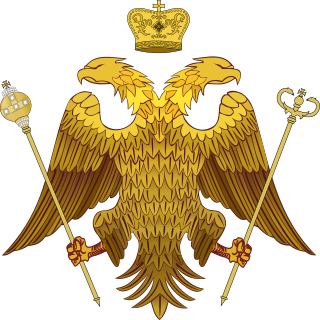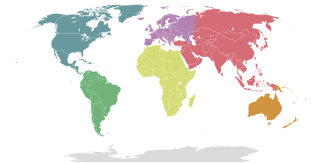
Nicosia, also known as Lefkosia in Greek, its Turkish name Lefkoşa, is the capital and largest city of Cyprus.

The Greek War of Independence, also known as the Greek Revolution or the Greek Revolution of 1821, was a successful war of independence by Greek revolutionaries against the Ottoman Empire between 1821 and 1829. In 1826, the Greeks were assisted by the British Empire, Kingdom of France, and the Russian Empire, while the Ottomans were aided by their North African vassals. The war led to the formation of modern Greece, which would be expanded to its modern size in later years. The revolution is celebrated by Greeks around the world as independence day on 25 March.

The Church of Cyprus is one of the autocephalous Greek Orthodox churches that together with other Eastern Orthodox churches form the communion of the Eastern Orthodox Church. It is one of the oldest Eastern Orthodox autocephalous churches; it claims to have always been independent, although it may have been subject to the Church of Antioch before its autocephaly was recognized in 431 at the Council of Ephesus. The bishop of the ancient capital, Salamis was constituted metropolitan by Emperor Zeno, with the title archbishop.

Makarios III was a Greek Cypriot archbishop, primate, statesman and politician, who served as the first President of Cyprus between 1960 and 1977. He was also the Archbishop of the autocephalous Church of Cyprus from 1950 to 1977.
Greek Cypriots are the ethnic Greek population of Cyprus, forming the island's largest ethnolinguistic community. According to the 2011 census, 659,115 respondents recorded their ethnicity as Greek, forming almost 99% of the 667,398 Cypriot citizens and over 78% of the 840,407 total residents of the area controlled by the Republic of Cyprus. These figures do not include the 29,321 citizens of Greece residing in Cyprus, ethnic Greeks recorded as citizens of other countries, or the population of Northern Cyprus.

The Eyalet of Cyprus was an eyalet (province) of the Ottoman Empire made up of the island of Cyprus, which was annexed into the Empire in 1571. The Ottomans changed the way they administered Cyprus multiple times. It was a sanjak (sub-province) of the Eyalet of the Archipelago from 1670 to 1703, and again from 1784 onwards; a fief of the Grand Vizier ; and again an eyalet for the short period from 1745 to 1748.

The Ecclesiastical coup is the name given to the events staged by three bishops of the Orthodox Church of Cyprus against the President of the Republic of Cyprus, Archbishop Makarios III, in the period from March 1972 to July 1973.

Strovolos is a municipality in the Nicosia district. With a population of nearly 71,123, it is the second most populated municipality in Cyprus, after Limassol, and the most populated municipality of Nicosia District. It was established in 1986.

The Pancyprian Gymnasium, is the oldest still operational high school in Cyprus, founded in 1812.
This is a timeline of modern Greek history.
Archimandrite Kyprianos was a cleric, historian, poet, and publishing editor. He was one of the major Greek Cypriot intellectuals and clerics of the 18th century.

There were numerous massacres during the Greek War of Independence (1821–1829) perpetrated by both the Ottoman forces and the Greek revolutionaries. The war was characterized by a lack of respect for civilian life, and prisoners of war on both sides of the conflict. Massacres of Greeks took place especially in Ionia, Crete, Constantinople, Macedonia and the Aegean islands. Turkish, Albanian, Greeks, and Jewish populations, who were identified with the Ottomans inhabiting the Peloponnese, suffered massacres, particularly where Greek forces were dominant. Settled Greek communities in the Aegean Sea, Crete, Central and Southern Greece were wiped out, and settled Turkish, Albanian, Greeks, and smaller Jewish communities in the Peloponnese were destroyed.
Religion in Cyprus is dominated by Eastern Orthodox branch of Christianity, whose adherents make up 73% of the total population of the entire island. Most Greek Cypriots are members of the autocephalous Greek Orthodox 'Church of Cyprus'. Most Turkish Cypriots are officially Sunni Muslims. There are also Baháʼí, Catholic, Jewish, Protestant, Armenian Apostolic, and non-religious communities in Cyprus.

The Cyprus Folk Art Museum is a museum in Cyprus dedicated to the country's ethnographic history. The museum is located in Nicosia directly beside the Cathedral of Agios Ioannis Evangelistis, the Byzantine Museum of Cyprus, the National Struggle Museum, and the current Archbhishop's Palace. The square beside the cathedral and museum is named after Kyprianos of Cyprus who was executed by the Ottomans in 1821 for his support of the Greek Revolution. Facing the museum and cathedral is the Pancyprian Gymnasium, founded in 1812 by Kyprianos and is the oldest educational institution in Cyprus. During the 1990s the name of the museum was changed to the Ethnographic Museum for a short period. The museum is a non-profit cultural organisation and has depended on volunteers since it was founded in 1937.
This is a timeline of the presence of Eastern Orthodoxy in Greece from 1821 to 1924. The history of Greece traditionally encompasses the study of the Greek people, the areas they ruled historically, as well as the territory now composing the modern state of Greece.
Ayios Loukas is a Neighbourhood, Quarter, Mahalla or Parish of Nicosia, Cyprus and the parish church thereof. The church was dedicated to and named after St. Luke the Apostle and the parish or neighbourhood was named after the church. It is Άγιος Λουκάς in Greek and Ayluka or the new name Ayyıldız in Turkish.

Christianity in Cyprus is the largest religion in the country, making up 78% of the island's population. The largest Christian denomination is the Greek Orthodox Church, while the rest are smaller communities of Anglicans, Roman Catholics, Latin Christians, Maronites, Armenian Apostolics, and Greek Evangelicals.

Gregorios Theocharous of Thyateira and Great Britain served as the Greek Orthodox Archbishop of Thyateira and Great Britain under the Ecumenical Patriarchate of Constantinople. He was elected Archbishop by the Sacred and Holy Synod of the Ecumenical Patriarchate on 16 April 1988. He resigned on 12 June 2019 for health reasons and has been succeeded by Nikitas Loulias. He died on 20 November 2019. His funeral took place on 5 December 2019 at St Mary's Greek Orthodox Church, Wood Green.











